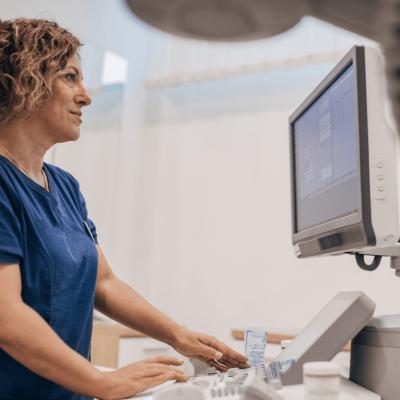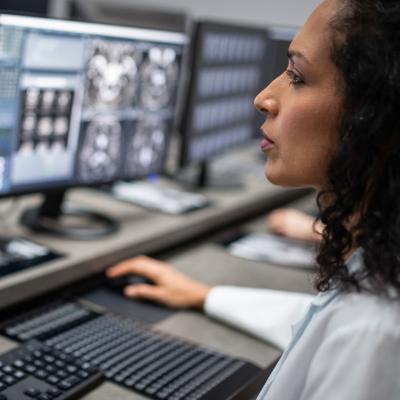- AdventHealth University

Last updated September 15, 2025.
Imagine if you could see inside your body without having to go through surgery.
Nuclear medicine makes this possible by using small and safe amounts of radioactive materials to assist in viewing the function of various organs and tissues. This unique approach allows for the assessment of organ function, identification of diseases, and careful monitoring of treatment progress.
Nuclear Imaging
Nuclear medicine imaging works by using radioactive tracers (usually an isotope attached to a specialized compound) tailored for a specific organ, organ system or tissue type.
This radioactive tracer (or radiopharmaceutical) is either injected into the body or swallowed in a pill. Then it travels through the body and allows specialized imaging devices, such as gamma cameras or PET scanners, to detect the emitted gamma rays or positrons and create detailed images that provide information about the functioning and structure of organs and tissues.
Uses of Nuclear Medicine
Nuclear medicine allows doctors to see details that may not be visible with other imaging techniques.
For example, it can be used to:
- Diagnose heart problems by assessing cardiac blood flow, identifying areas of reduced blood supply and evaluating heart function
- Diagnose and detect various types of cancer, including breast, lung, prostate and bone cancer
- Diagnose liver abnormalities and diseases
- Diagnose and monitor brain conditions, such as epilepsy, Alzheimer's disease and Parkinson's disease
- Employ "theranostics" to both diagnose and treat disease
Therapeutic procedures are also growing in nuclear medicine. An isotope can emit radiation to kill cancerous or diseased cells in a localized area with minimal risks to the surrounding tissue.
Jobs in Nuclear Medicine
Nuclear medicine offers a wide range of job opportunities. You may choose to specialize in a particular area, such as diagnostic imaging, therapeutic radiology or radiation safety. A nuclear medicine technologist will typically work at hospitals, outpatient imaging centers, mobile imaging clinics, or as application specialists.
As a Nuclear Medicine Technologist, you'll perform diagnostic tests, administer radiopharmaceuticals and monitor patients during and after a procedure. You'll also review test results and communicate them to the physician.
AdventHealth University’s Bachelor of Science in Nuclear Medicine Technology program teaches all of these skills and also offers Computerized Tomography education and clinical training. The bachelor’s program at AHU is one of fewer than 15 programs in the country in which a student is qualified to take both nuclear medicine and CT board exams upon graduation, and the only such degree program offered in the Central Florida area.
Once certified in both areas, graduates are eligible for multiple employment opportunities. Many graduates of the program have also gone on to work in radiation safety, management, pharmaceutical or medical device industries. You can learn more in our blog with helpful tips about “How to Become a Nuclear Medicine Technologist, “Benefits of Interventional Radiology” and even “How to Become a Radiology Director.”
Duties of a Nuclear Medicine Technologist
The main responsibilities of a nuclear medicine technologist may include:
Patient Preparation
This includes explaining the procedure, addressing any concerns or questions, and ensuring that patients are adequately prepared, which may involve fasting or discontinuing certain medications before the procedure.
Radiopharmaceutical Administration
This includes calculating, measuring and safely and precisely administering appropriate tracer dosages to patients.
Imaging and Scanning
Nuclear medicine technologists operate specialized imaging equipment to capture images of organs and tissues. They position patients correctly, calibrate equipment and create high-quality images that accurately represent the distribution of the radiopharmaceuticals within the body. Technologists also monitor patients during scans, ensuring their comfort and cooperation throughout the procedure.
Image Analysis and Reporting
After generating the images, nuclear medicine technologists play an important role in reviewing and analyzing them. They assess image quality, identify any abnormalities or areas of interest and prepare detailed reports for radiologists or nuclear medicine physicians.
Radiation Safety and Quality Control
Nuclear medicine technologists are responsible for maintaining strict radiation safety protocols to protect patients, themselves and other health care professionals. They ensure that all equipment is functioning properly, perform quality control tests and adhere to regulatory guidelines. Technologists also educate patients and staff about radiation safety measures and monitor radiation exposure levels to maintain a safe working environment.
In addition to these primary duties, nuclear medicine technologists may also be involved in research, quality improvement initiatives, and patient education, providing information on procedures, addressing concerns and offering post-procedure care instructions.
Start Your Career in Nuclear Medicine
Nuclear medicine is a valuable diagnostic and therapeutic tool that plays a major role in guiding modern health care decisions and improving patient outcomes. AdventHealth University offers a cutting-edge Bachelor of Science in Nuclear Medicine Technology program that prepares graduates to work in a variety of medical settings. If you are interested in this field, you can request information to have a member of our team contact you, answer any questions, and help you take the first step toward your degree in nuclear medicine.
Sources
Society of Nuclear Medicine and Molecular Imaging, "What is Nuclear Medicine?"
American Cancer Society, "Nuclear Medicine"
Mayo Clinic, Mayo Foundation for Medical Education and Research, "Nuclear Medicine"


